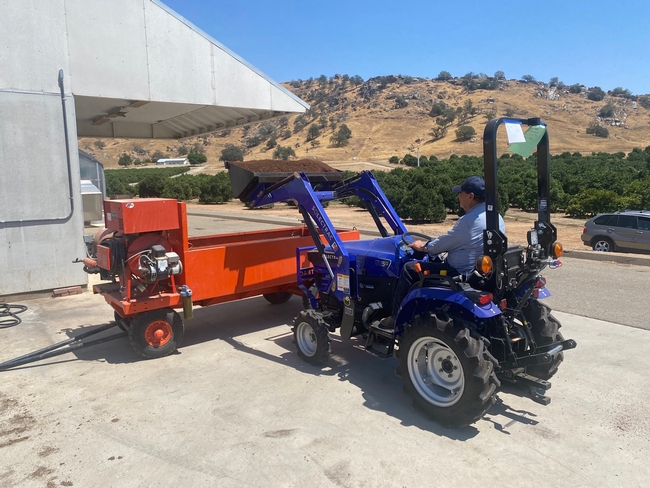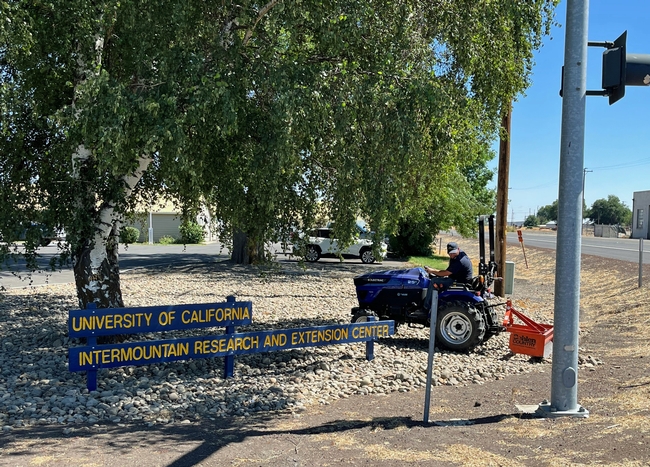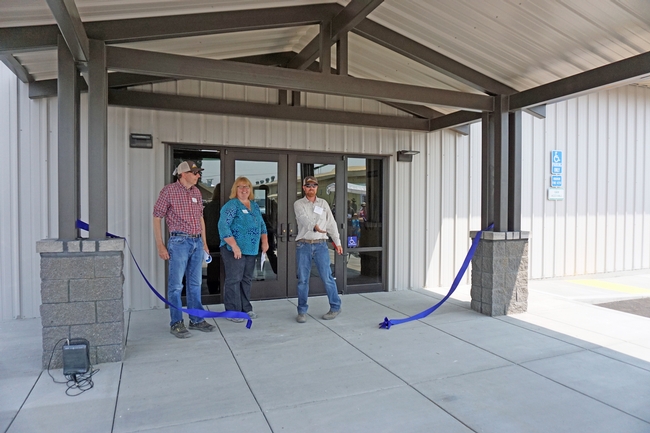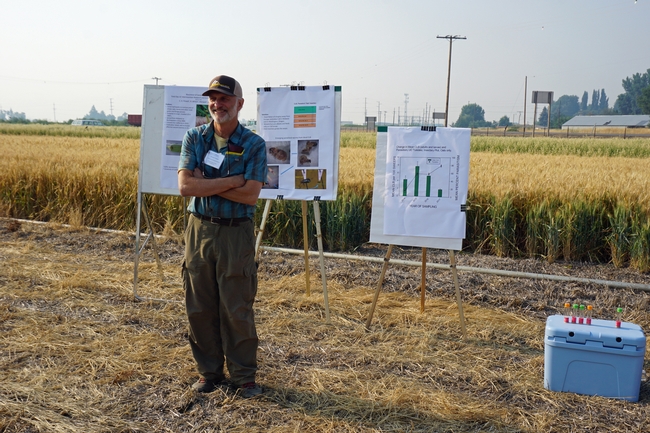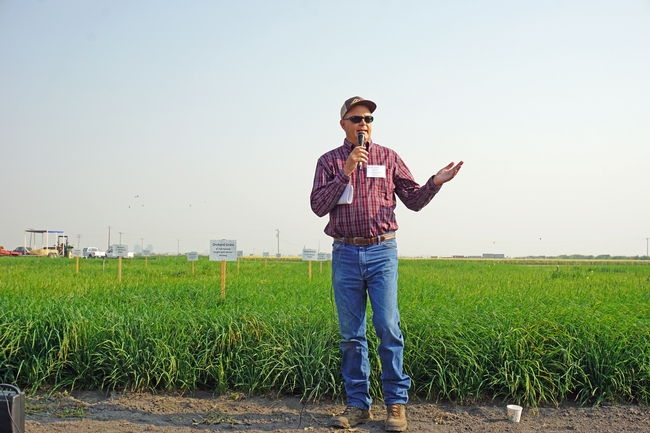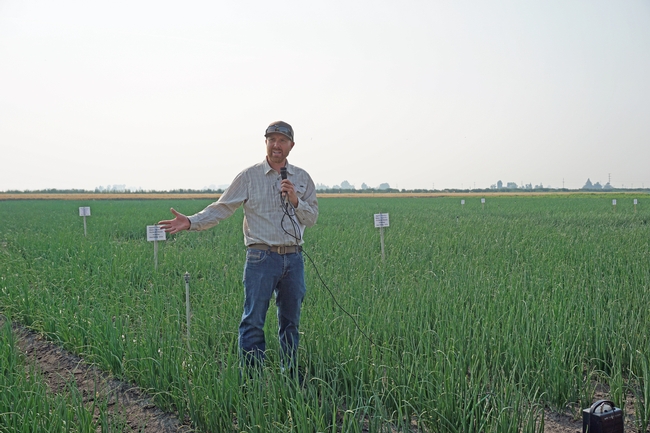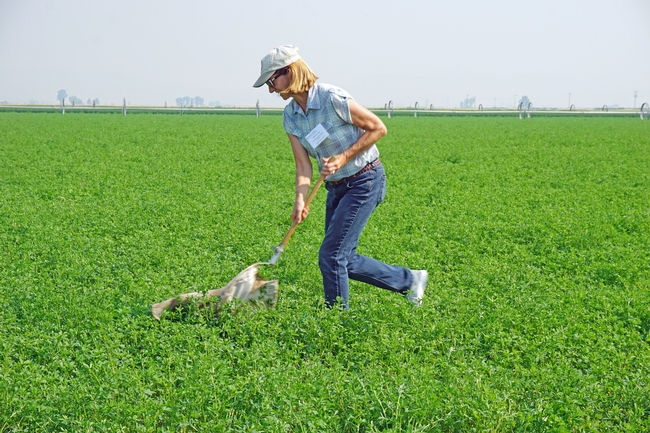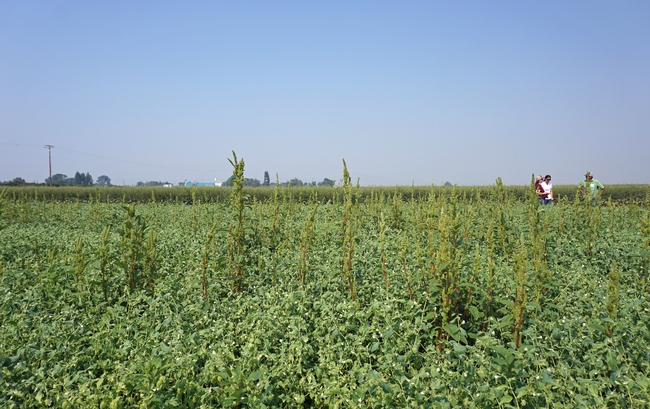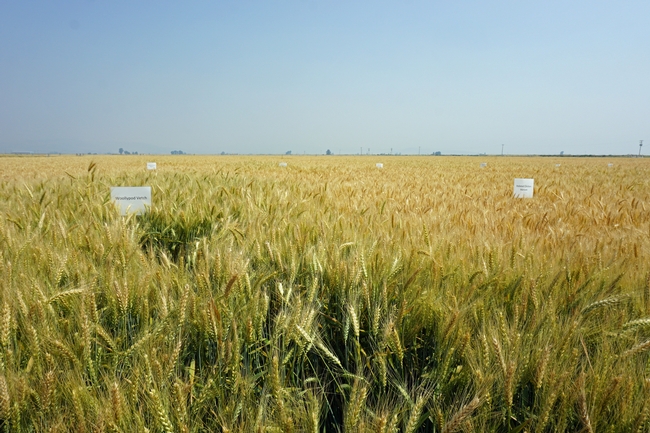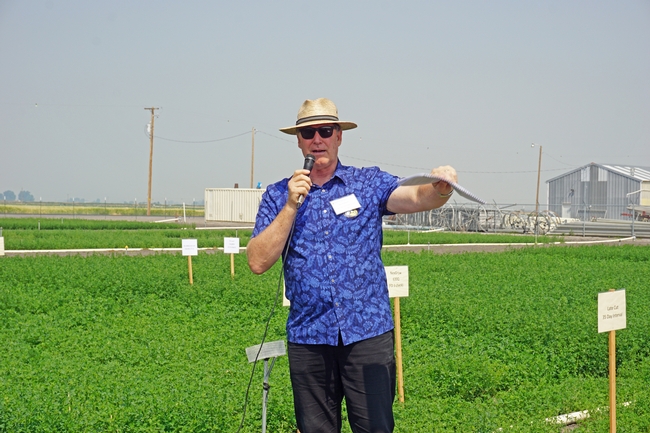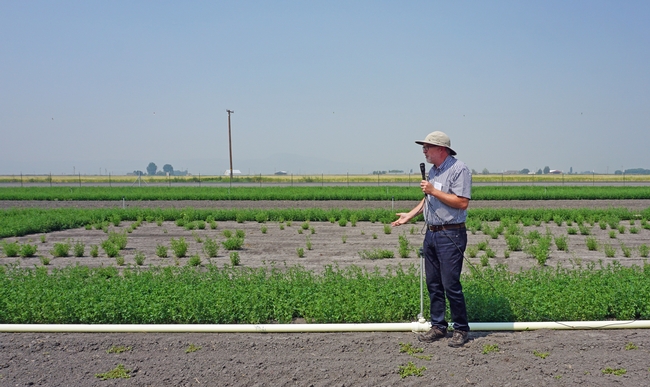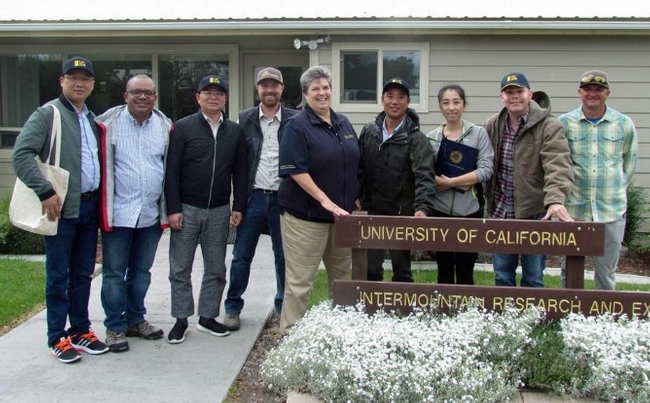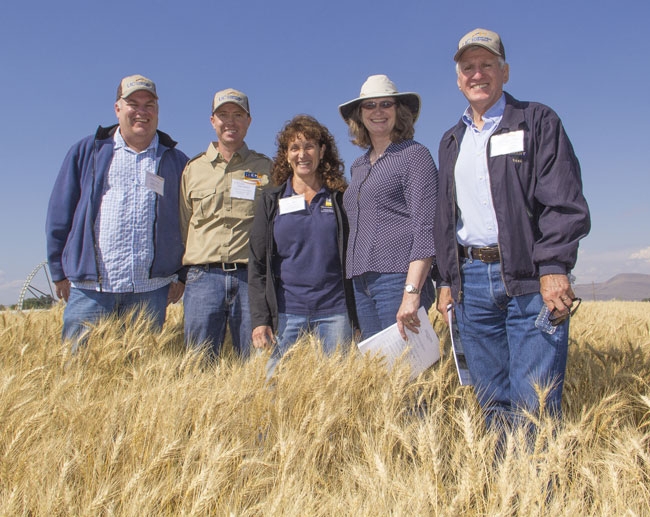Posts Tagged: Rob Wilson
Electric tractors reduce carbon emissions at UC ANR research and extension centers
Zero-emission tractors perform many tasks of diesel tractors, without noise or exhaust
The University of California, a national leader in sustainability, has pledged to become carbon neutral by 2025. To reduce its reliance on fossil fuels, UC Agriculture and Natural Resources has replaced several of its diesel-powered tractors with electric tractors at its research and extension centers.
Seven of the nine UC research and extension centers – Intermountain located in Siskiyou County, Hopland in Mendocino County, Kearney and West Side in Fresno County, Lindcove in Tulare County, Desert in Imperial County and Hansen in Ventura County – started using the Solectrac e25 in July. The researchers plan to share what they learn from using the electric tractors.
“Charging is easy, we are using a standard 110V connection, no charging station needed,” said John Bailey, director of the University of California Hopland Research and Extension Center. “For faster charging, you can use a 220V connection – again, no charging station needed, just a regular receptacle – but we haven't gone there yet.”
The electric tractor runs for about five hours, depending on the type of use and the speed, on a charge.
“We will use the electric tractor to mix the soil for planting trees in the greenhouse,” said Ashraf El-kereamy, director of UC Lindcove Research and Extension Center in Exeter, which focuses on citrus research. “Also, for pulling the trailer with the fruit bins during harvest, it will be good as it does not emit any gases.”
The electric tractor is being used to move materials in the loader at UC Hopland REC. “It has worked well for this, functioning similarly to a standard diesel tractor,” said Bailey.
“We have also used it to clean our sheep barn, scraping the pens to get ready for lambing season,” Bailey said. “This involves pushing or dragging straw bedding and manure. The tractor functions well in tight spaces due to its compact size.”
Bailey learned one downside is that the front end is a little too light, making it difficult to generate enough downward pressure with the loader to effectively scrape the floor without reducing the front wheel traction.
“We are planning to add some weight to the front, a standard practice with tractors to increase traction. The tractor has the mounting to enable this so it should not be a big deal,” Bailey said. “Our operators really appreciate the lack of noise and exhaust, especially when working in the barn or in tight spaces.”
The small electric tractor is also being used in tight places at the UC Intermountain Research and Extension Center in Tulelake.
“The tractor that we obtained from the company is too small for the majority of our farm needs,” said Rob Wilson, Intermountain REC director. “We purchased a small box scraper and rototiller for the tractor and we are using it around our facility grounds. We also use it out in the field in tight spaces that are too small for our larger tractors to operate.”
“The tractor is quiet, powerful for its size and operates very similar to the diesel-powered tractors with regard to the controls, hydraulics and three-point assembly. The tractor also has a lot of torque and speed.”
Annemiek Schilder, director of UC Hansen Agricultural REC, added, “I think another advantage is that the tractors can go very slowly, which is helpful for some uses such as harvesting.”
The researchers will continue to evaluate the electric tractors throughout the year.
“Our main usage will come in the spring, mowing around our headquarters and on roadsides,” Bailey said. “We are purchasing a 4-foot flail mower that can mount to the rear PTO, but won't really put it into use until April.” The power take-off, or PTO, is the shaft that transfers power from the tractor to the attachment.
Other benefits of electric tractors include no engine oil to change and no diesel fuel.
“If the farmer already has solar, they will see close to zero fuel charges,” Bailey added. “Even without solar, their fuel costs should be reduced depending on local electrical cost. Also, the engine only has one moving part compared to dozens in a diesel tractor so maintenance costs should be reduced significantly, something that is proving true in electric cars.”
The Solectrac e25 tractors each cost $27,999 and the optional loader was about $4,000.
The California Air Resources Board is offering incentives to buy zero-emission equipment through its Funding Agricultural Replacement Measures for Emission Reductions Program. FARMER provides funding through local air districts for agricultural harvesting equipment, heavy-duty trucks, agricultural pump engines, tractors and other equipment used in agricultural operations.
Siskiyou County Board of Supervisors gives 4-H a vote of confidence
Not only did the Siskiyou County Board of Supervisors approve a $10,000 allocation to the local 4-H program, commissioners spoke warmly about the youth development program, reported Bill Choy in the Mt. Shasta News.
“Without 4-H I don't think my kids would have been as successful,” said commissioner Ray Haupt. He said he has seen the positive benefits of 4-H for kids and teens countless times and added that the program provides invaluable leadership skills to the youth in the community.
UC Cooperative Extension advisor Rob Wilson addressed the board to request the funding support. He said state funds have not kept up with the cost of running the program.
"We're having more difficulty covering that funding gap," Wilson said.
He added that the program is always looking for help and donations and encouraged the community to support them. For more information go to http://cesiskiyou.ucanr.edu/4-H_Program/.
Read more about the Siskiyou Pet Pals 4-H program.
UC research facility brings state-of-the-art conferencing to Tulelake
UC Agriculture and Natural Resources marked the opening of a new conference and laboratory building at its Intermountain Research and Extension Center in Tulelake July 26, bringing to the region a state-of-the-art facility for business meetings, job fairs, trainings, conferences and community events.
"The facility is the first in the Tulelake area to offer modern audio-visual infrastructure and high-speed internet connectivity capable of supporting remote presentations to stay in touch with groups from around the world," said Rob Wilson, IREC director. "We hope this facility will greatly increase the visibility and accessibility of local events and help draw more regional attention to the area."
UC ANR funded construction of the $2 million building. IREC is working with the community to complete the project with furnishings and equipment.
The conference room is named after John Staunton, a local farmer and supporter of IREC whose family donated $25,000 in his memory to the project. Another conference room bears the name of Winema Elevators/Western Milling for its gift of $15,000. Donations to the facility have also been made by Sensient Natural Ingredients, Macy's Flying Service and Basin Fertilizer
The conference building opening followed the 2018 IREC field day, an annual event that showcases the research underway at the 140-acre facility.
Research presentations included updates about work on biological control of cereal leaf beetle, influence of fall harvest management of irrigated grass hays, onion white rot, managing alfalfa weevil and clover root cucurlio, pulse crop options for the Klamath Basin, cover crops and amendments, cutting schedule effects on low lignin alfalfa and germplasm evaluation of alfalfa and tall fescue.
Chinese scientists visit UC ANR's research center in Tulelake
UC Agriculture and Natural Resources vice president Glenda Humiston welcomed a delegation of Chinese agricultural scientists to UC ANR's Intermountain Research and Extension Center in Tulelake in June, reported Danielle Jester in the Siskiyou Daily News.
"They're trying to improve their agriculture," Humiston said. "We need all farmers and ag working together, and we need a good working relationship with China – there's a big market there.”
During her opening remarks, Humiston said Chinese farmers faced many of the same issues as those in the U.S.
"They are responding to global climate change, drought and pests while trying to improve food security and water use efficiency," Humiston said. "They see UC Cooperative Extension as an effective research model; we hope that scientific collaborations will accelerate solutions and help maintain relations for California agriculture with China."
The group toured the Intermountain Research and Extension Center, the northernmost of UC ANR's nine research and extension centers.The 140-acre facility is four miles south of the Oregon border. Research at the center is focused on irrigated field and vegetable crops, weed, insect and disease management, water conservation and plant fertility.
During the tour of the station, one of the Chinese scientists asked what factors the researchers look at to determine the health of the soil. In response, center director Rob Wilson listed the soil's nutrients, its bulk density, pH, organic matter content, carbon to nitrogen ratios, existence of microbes, and existence of disease in the soil, Jester reported.
UC research center in Tulelake commemorates UCCE centennial
The annual field day at the UC Intermountain Research and Extension Center held last week provided an opportunity to mark the 100th anniversary of UC Cooperative Extension with leaders of the organization, reported Todd Fitchette in Western Farm Press.
The research activities at the Intermountain center, situated near the California-Oregon border in Tulelake, focus on peppermint, horseradish, small grains, wheat, potatoes, alfalfa and onions. At the field day, UCCE researchers discussed the progress of alfalfa production in the Klamath Basin, suppressing white rot disease in processing onions, maximizing profitability of wheat, pest management in peppermint and other topics.
The Intermountain Research and Extension Center is one of nine centers under the UC Division of Agriculture and Natural Resources (ANR). The 140-acre facility provides UCCE advisors and specialists the space and support needed to conduct agricultural research in a high mountain interior valley climate zone.

